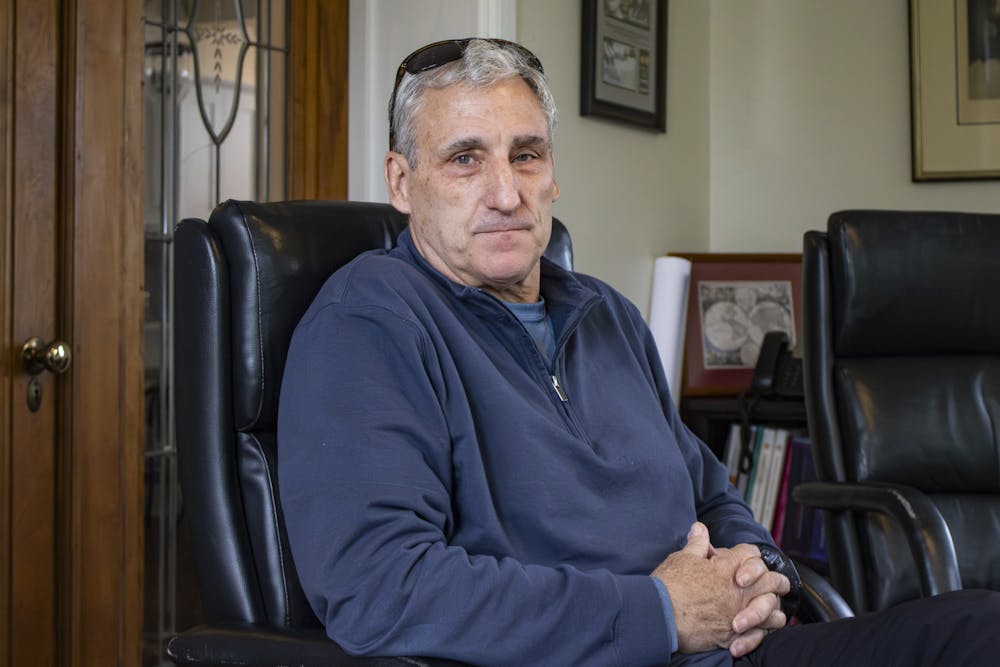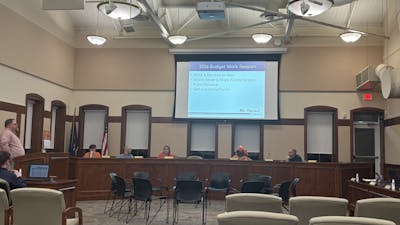Former instructor claims CMU rifle range poisoned him with lead

Former CMU instructor and rifle range manager Michael Brewer sits for a photo on May 21, 2025. (CM Life | Blace Carpenter)
Seizures, memory loss, a feeding tube — these are the results of U.S. Army Sgt 1st Class Michael Brewer’s lead poisoning that he claims he received during his work at Central Michigan University’s rifle range in the basement of Finch Fieldhouse in the 1990s.
Brewer instructed classes at the range from 1996 through 1998. Shortly after he arrived on campus, Brewer began to feel ill and had to medically retire. Almost 10 years later, he learned about lead poisoning, and he sued CMU in 2011.
But Brewer said he doesn’t want any compensation from CMU. His biggest worry is his students. There are about 2,500 who took classes at the gun range in the 1990s, and Brewer claims it might have exposed them to lead as well.
“I’m requesting that each one of them be found and notified about the contamination,” Brewer said. “What they do with it is up to them. … I’m not stopping. This is my mission in life.”
CMU provided Central Michigan Life with a statement that they’re aware of Brewer’s claims, and that there were no findings against CMU and the lawsuit was dismissed.
“The indoor rifle range is still in use by CMU’s Military Science and ROTC programs,” a CMU’s spokesperson wrote in an email. “CMU Environmental Health and Safety works with the Military Science program to monitor lead levels and to provide cleaning for the range.”
Instructing military classes at CMU
Brewer started at CMU in 1996 by teaching a course on survival skills and rappelling, but the course was eventually closed. He later took on the role of manager of the university’s rifle range, which served as a location for marksmanship training for ROTC students.
He joined the U.S. Military in 1981 and served in several positions in the Army, such as a special weapons operator, gunnery sergeant, drill sergeant and more. During his time in active duty, he was deployed to parts of Central America and Europe. He was also stationed in different bases around the United States.
At CMU, Brewer said, he worked long hours in the range and had extensive exposure to the microscopic particles of lead that are shaved off of bullets as they travel down the barrel of a rifle. Additionally, he had to clean the piles of lead dust that accumulated from spent .22-caliber bullets. He said he was never told how to clean it properly, and he wasn’t aware of the dangers of lead when he oversaw the rifle range.
“At that time, it was like cleaning anything else,” Brewer said. “I didn’t know. The Army didn’t train me, no one told me that the stuff was hazardous.”
Brewer said he quickly fell ill, but would continue to oversee the range. From June to December 1997, Brewer was traveling back and forth from Walter Reed National Military Medical Center in Washington, D.C. and CMU to find a diagnosis for his ongoing seizures.
“Imagine ...all you’ve gone through,” Brewer said. “I was getting ready to retire from the Army. I had 17 years in. I went to college every night when I was in the Army so that I don’t have to do it when I got out. So I come out to a career. (It all was) gone.”
In 2012, CMU’s former General Counsel, Manuel Rupe, told CM Life the university denied having any knowledge of contamination.
Symptoms and diagnosis of lead poisoning
When Brewer left CMU in 1998, he continued to have seizures, memory loss, severe stomach pains, loss of weight and migraines, he said.
“I chewed out all my teeth in the range (during seizures),” Brewer said. “I woke up (with) teeth laying on the floor. … I lost the ability to swallow.”
Brewer had an oral prosthesis and a feeding tube. Within five years, he wasn’t able to walk and had to be in a wheelchair, he said.
For many years, doctors didn’t know what was happening. Brewer said he received several misdiagnoses.
Ultimately, doctors gave him the worst news imaginable: “There’s nothing to be done,” Brewer said they told him. “Go and die.”
It wasn’t until 2011 that Brewer learned about the lead poisoning. He went to doctor Abid Khan in Clare, who was from Afghanistan and knew what heavy metal contamination looked like because of the war there.
“What I didn’t know at that time (about) heavy metals (is) once you leave the contaminated area, it goes to your bones, and it doesn’t show up in your bloodstream, only in small amounts,” Brewer said. “It leaches out to your bones, so your bones are a reservoir of the heavy metal.”
According to Brewer’s medical records, his lead level at the time of diagnosis was 25 micrograms per deciliter. The safe level of lead in a human body is below 3.5 micrograms per deciliter, according to the Centers for Disease Control and Prevention.
“The patient is under my care, and has recently been diagnosed with lead poisoning with residual problems,” Khan wrote in an August 2011 letter to the Gratiot County Department of Veteran Affairs. “After reviewing his lead exposure history, he has confirmed that there was excessive lead in the firing range at CMU in 1995 to 1998 where he was stationed at the Central Michigan University ROTC Detachment. He has chronic symptoms that are disabling including multiple neurological symptoms.”
Brewer underwent treatment to remove the lead from his body. But even now, he said, he still feels it.
“I can only be awake about four hours, and my brain shuts down,” Brewer said. “If it was sunshine shining out right now, I would have to have these (specialized sunglasses) on. These are made for that, because the lead on my eyes causes severe migraines.”
Legal battles
In 2011, Brewer filed a lawsuit against CMU, claiming lead poisoning. The case moved from Isabella County to Lansing within a month and was rejected because it was filed past the statute of limitations.
In 2015, Brewer, with the help of a law firm from Grand Rapids, filed another lawsuit. This time, he sued the U.S. Army.
The Army investigated the potential workplaces where Brewer could have gotten the lead poisoning, and on March 30, 2017, the Army Review Boards Agency — the highest military court — ruled that Brewer was indeed poisoned by lead.
“During the investigation, it was discovered that lead contamination in 1998 where he was working was concealed from him by the Army,” the board’s ruling on March 30, 2017 read. “The doctors at the Walter Reed Army Medical Center were so perplexed about how sick he was and could not find a diagnosis. They gave him a diagnosis that is given to just about anyone who they give up on. The lead went to his bones, not in his bloodstream for detection.”
Brewer was permanently retired and received 100% disability and special monthly compensation from the Army. The benefit, he said, is enough to keep him homed and to cover his medical bills; however, it doesn’t mitigate the damage done.
After years of fighting, Brewer felt he was, “left for dead.”
In 2023, Brewer said he wanted to talk with CMU officials once again. But after they refused to see him, he sent a text message to his ex-wife that CMU claimed was threatening in nature. He was criminally charged and spent five months in jail.
“They want nothing to do with me,” Brewer said of the university. “They want me to shut up. Let’s put it this way: ... I was falsely charged and thrown in jail.”
To CMU and the Army, Brewer’s message is clear.
“Be accountable,” he said. “It’s not too late.”
The history of CMU’s rifle range
Known today as the Brigadier General John G. Kulhavi Rifle Range, it still serves as a place for marksmanship training for the ROTC and police academy. Brewer said that during his time as an instructor, students from Ferris State University and members of the public would utilize the facility.
CMU Military Science Department Chair Lt. Col. Ryan Greening said that it is still the case.
“It started off as a range for all,” Greening said. “For multiple departments, not just ROTC.”
He said that the range meets OSHA standards and is tested annually for lead contamination. He said no one from the university cleans the lead and that it was contracted to a cleaning company based in Texas. Inspectors come around April and May to inspect for lead contamination and clean the facility.
Central Michigan Life filed a Freedom of Information Act request with CMU requesting the OSHA evaluations from 2025, 1992 and 1998. On Aug. 25, CMU denied the FOIA, saying that the university has no records responsive to CM Life's request.
In July 1997, former Assistant Professor of Military Science Gail Koch sent a letter to CMU asking for funding to clean up the lead in the gun range. A couple of months prior, different companies put forward their bids to clean up the lead.
“The Military Science Department was recently informed that there was no money available for removing the lead from spent ammunition and cleaning the rifle range located in the basement of Finch,” the letter read.
In September 2004, the Rifle Range was renovated after former CMU Board Trustee John G. Kulhavi, who retired from the U.S. Army as a Brigadier General, donated $26,000 to renovate the gun range.
Kulhavi told CM Life at the time that the facility needed to be upgraded and lacked proper funds to operate.
“I decided to sponsor the project because the old facility wasn’t safe, there was a lack of equipment and the program receives no funding from the university,” Kulhavi told CM Life reporters in 2004.
Today, a sign that reads “ Warning: Poison lead dust area” and a large ventillation system hang at the rifle range entrance.






